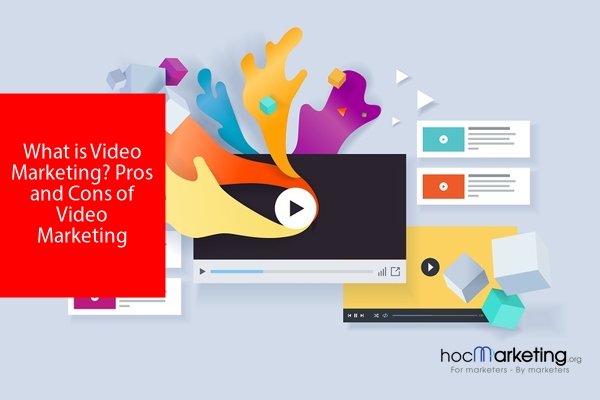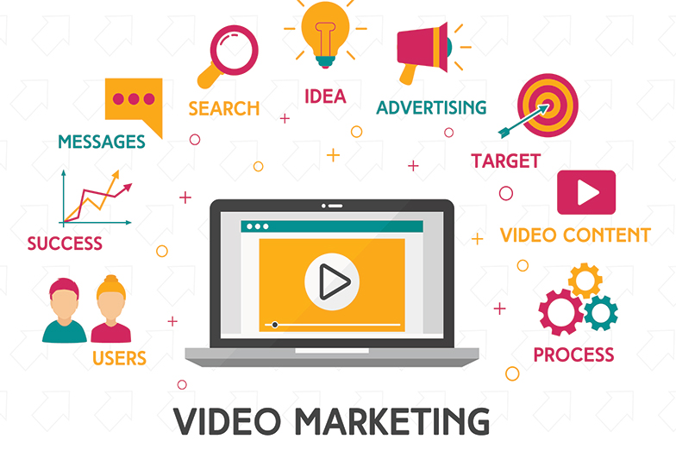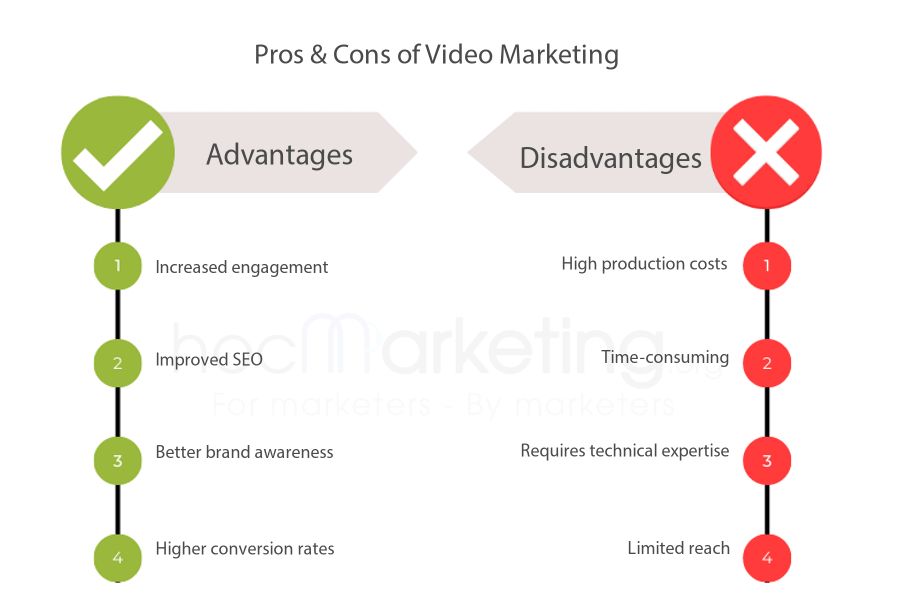
What is Video Marketing? Pros and Cons of Video Marketing

Learn about the advantages and disadvantages of video marketing. Discover how it can boost engagement, SEO, and brand awareness. Find out how to optimize your videos for mobile and drive conversions with clear calls-to-action.
Video marketing has become a popular strategy for businesses to promote their brand and connect with their audience. With the rise of social media and video-sharing platforms, such as YouTube and TikTok, video marketing has become more accessible and effective than ever before. But what exactly is video marketing, and what are its pros and cons? In this blog post, we will explore the definition of video marketing, its benefits and drawbacks, and best practices for a successful video marketing campaign.
What is Video Marketing?
Video marketing is a powerful tool that businesses can use to connect with their target audience and promote their products or services. As the name suggests, video marketing involves creating and sharing videos that showcase your brand, products, or services. This can be done through various channels such as social media, email marketing, and your website. Video marketing has become increasingly popular in recent years as a result of the growth of online video platforms and the proliferation of mobile devices. In the following sections, we will explore the pros and cons of video marketing and provide best practices for creating effective video content.
Pros of Video Marketing
Video marketing has become a popular trend in the world of digital marketing. Through the use of videos, businesses can convey their message to their target audience in a more engaging way. In this section, we will discuss the pros of video marketing.
Firstly, video marketing can increase engagement. Studies have shown that videos have a higher engagement rate than any other form of content. Videos can capture the attention of the audience and keep them engaged throughout the duration of the video. This can lead to higher engagement rates and increased brand loyalty.
Secondly, video marketing can improve SEO. Search engines such as Google tend to rank pages with videos higher than those without. This is because videos can increase the time spent on a website and decrease the bounce rate. Additionally, videos can increase the number of backlinks to a website, which is an important factor in SEO.
Thirdly, video marketing can create better brand awareness. Videos allow businesses to showcase their products and services in a more creative way. This can help businesses to stand out from their competitors and create a unique brand identity. Additionally, videos can be shared on social media platforms, which can increase the reach of the brand.
Lastly, video marketing can lead to higher conversion rates. Videos can effectively communicate the benefits of a product or service. This can lead to a higher number of conversions as the audience is more likely to be convinced about the value of the product or service.
Overall, video marketing has many advantages for businesses. From increased engagement to higher conversion rates, videos can help businesses to achieve their marketing goals.
Increased engagement
Video marketing has become increasingly popular in recent years due to its ability to captivate audiences and drive engagement. One of the main advantages of video marketing is its ability to increase engagement. Compared to other types of content, videos have been shown to be more effective in capturing and retaining the attention of viewers. This is because videos are able to convey information in a more dynamic and visually appealing way, which can help to keep viewers engaged and interested in the content.
In addition, videos can also be used to create a more emotional connection with viewers, which can help to build trust and loyalty with your audience. By using storytelling, humor, or other creative techniques, videos can help to evoke emotions and create a more memorable experience for viewers.
Overall, increased engagement is one of the key benefits of using video marketing. By creating engaging and compelling videos, businesses can capture the attention of their target audience and drive higher levels of engagement, which can ultimately lead to increased brand awareness, higher conversion rates, and a stronger online presence.
Improved SEO
Video marketing can be a great tool for improving your website's search engine optimization (SEO). Search engines like Google prioritize websites that have high-quality, engaging content, and video is a great way to achieve that. By creating video content that is relevant to your industry or niche, you can improve your website's search engine ranking and increase your visibility online.
One way that video can improve your SEO is by increasing the amount of time that visitors spend on your website. When people watch a video, they are more likely to stay on your site for longer, which tells search engines that your website is valuable and relevant to the user's search query. Additionally, video can improve your website's bounce rate, which measures the percentage of visitors who leave your site after viewing only one page. If your video is engaging and relevant, visitors are more likely to explore your website further and visit multiple pages.
Another way that video can improve your SEO is by increasing the number of backlinks to your website. Backlinks are links from other websites that point to your site, and they are an important factor in determining your website's authority and relevance. When you create high-quality video content that is relevant to your industry or niche, other websites are more likely to link to your content, which can improve your website's search engine ranking and visibility.
Finally, video can help you target specific keywords and phrases that are relevant to your industry or niche. By optimizing your video content for specific keywords, you can improve your website's search engine ranking and visibility for those keywords. This can help you attract more visitors to your website and increase your visibility online.
Better brand awareness
Video marketing can do wonders for your brand awareness. By creating engaging and informative videos, you can attract more viewers and spread your brand message effectively. Video content is much more memorable than text or images, and it can help to create a lasting impression on your audience.
Through video marketing, you can showcase your brand's personality and values, which can help to build trust and credibility with your target audience. With the right approach, video marketing can help you to establish your brand as a thought leader in your industry and differentiate yourself from your competitors.
Moreover, video marketing can help you to reach a wider audience beyond your existing customer base. By sharing your videos on social media platforms and other online channels, you can attract new viewers who may not have heard of your brand before. This can help to increase your brand's exposure and attract more leads and customers in the long run.
To make the most of video marketing for your brand awareness, it's important to create high-quality, engaging videos that align with your brand message and values. By understanding your target audience and their preferences, you can create videos that resonate with them and encourage them to take action. In the next sections, we'll explore some best practices for video marketing that can help you to achieve your goals and maximize your ROI.
Higher conversion rates
One of the most significant advantages of video marketing is its ability to drive higher conversion rates. By creating engaging and informative videos, businesses can effectively communicate their message to their target audience and encourage them to take action. Whether it's signing up for a newsletter, making a purchase, or requesting more information, videos can be a powerful tool for driving conversions.
Studies have shown that incorporating videos into a marketing campaign can increase conversion rates by as much as 80%. This is because videos have a way of capturing and holding the attention of viewers, making them more likely to engage with the content and take action. Additionally, videos can help build trust and credibility with potential customers, making them more likely to make a purchase or take another desired action.
Another reason why video marketing can be so effective at driving conversions is that it allows businesses to showcase their products or services in a more compelling way. By demonstrating the benefits and features of a product or service through video, businesses can help potential customers better understand what they have to offer and why they should choose them over competitors.
Ultimately, the higher conversion rates that video marketing can deliver make it a valuable tool for businesses looking to improve their bottom line. Whether it's through increased sales, more leads, or better engagement, the benefits of video marketing are clear.
Cons of Video Marketing
While video marketing has numerous benefits, there are also some drawbacks to consider. One of the main cons of video marketing is the high production costs. Creating high-quality videos can require expensive equipment and editing software, as well as hiring professionals such as videographers, writers, and actors. This can be a significant investment for businesses, particularly small ones with limited budgets.
Another disadvantage of video marketing is that it can be time-consuming. From planning and scripting to shooting and editing, creating an effective video can take a lot of effort and resources. Additionally, it can take time to see results from video marketing, which can be frustrating for businesses looking for immediate returns on their investment.
Furthermore, video marketing requires technical expertise. Not only do businesses need to know how to use video editing software, but they also need to have a good understanding of lighting, camera angles, and other technical aspects of video production. This can be a challenge for those without experience in the field.
Finally, while video marketing can be effective in reaching certain audiences, it does have its limitations. For example, some people may not have the bandwidth or data to stream videos, while others may prefer other forms of content such as written articles or podcasts. This means that video marketing may not be the best option for reaching all audiences.
Despite these drawbacks, video marketing can still be a powerful tool for businesses looking to connect with their audiences. By understanding the pros and cons of video marketing, businesses can make informed decisions about whether or not to invest in this form of content marketing.
High production costs
One of the main drawbacks of video marketing is its high production costs. Unlike other forms of content marketing such as blog posts or social media updates, videos require a significant investment in terms of time, equipment, and production expertise. From scripting and storyboarding to filming and editing, each step in the video creation process has its own set of expenses that can quickly add up.
In addition to the actual production costs, businesses also need to consider the cost of promoting their videos through paid advertising or social media marketing campaigns. While these tactics can help increase the reach and visibility of their videos, they also require a significant investment of time and resources.
Despite these challenges, many businesses continue to invest in video marketing as they recognize the potential benefits it can bring. By following best practices and working with experienced professionals, businesses can create high-quality videos that engage and inspire their target audience while also driving measurable results for their business.
Time-consuming
Creating high-quality videos can be a time-consuming process. From conceptualization to scripting, filming, editing, and post-production, each step requires careful planning and execution. Depending on the complexity of the video, it can take several days or even weeks before the final product is ready for distribution.
Moreover, videos require regular updates to remain relevant and engaging. This means that businesses need to allocate resources to continuously create new content, which can add to the already high production costs. Additionally, videos need to be optimized for different platforms and devices, which requires additional time and effort.
Despite these challenges, the benefits of video marketing are too significant to ignore. By leveraging the power of videos, businesses can increase engagement, improve SEO, and drive higher conversion rates. However, it is important to balance the investment of time and resources with the expected returns to ensure that the overall strategy is sustainable in the long run.
Requires technical expertise
Creating a video for marketing purposes requires technical expertise in terms of video production and editing. It's not just about shooting a simple video with a smartphone camera. To create a professional-looking video, you need to have a good understanding of lighting, sound quality, camera angles, and editing software. This can be challenging for businesses that don't have an in-house video production team or the budget to hire one.
Furthermore, producing a video with a high-quality finish can be time-consuming, especially if you don't have any experience in video production. You need to spend time planning the video, scripting it, shooting it, editing it, and adding special effects if required. This process can take several weeks or even months, depending on the complexity of the video.
Apart from the technical challenges, there are also some limitations to video marketing. One of the biggest limitations is the reach. Even though videos can be shared on social media platforms and websites, they may not reach a wide audience. This is because not everyone has access to high-speed internet or the time to watch a video. Therefore, businesses need to make sure that their videos are optimized for different devices and internet speeds.
Overall, video marketing requires technical expertise, time, and resources. However, it can be a highly effective marketing tool if done right. Businesses should consider outsourcing video production to professionals or investing in training their in-house team to produce high-quality videos.
Limited reach
While video marketing has numerous advantages, it also comes with its own set of limitations. One of the main drawbacks of video marketing is its limited reach. Unlike other forms of marketing such as social media or email marketing, video marketing may not be accessible to everyone due to technological barriers, such as slow internet connections or outdated devices.
Moreover, not everyone may be interested in consuming video content. Some people may prefer to read or listen to content rather than watch a video. This limits the potential audience for your video marketing efforts. Additionally, some businesses may not have the resources to target a broad audience with video marketing, which can further limit their reach.
However, there are ways to overcome the limited reach of video marketing. For example, businesses can optimize their videos for SEO to increase their chances of appearing in search engine results and reaching a wider audience. They can also share their videos on multiple platforms, such as social media, email newsletters, or their website, to increase their visibility.
Furthermore, businesses can create different types of videos to cater to different preferences and interests. For instance, they can create explainer videos, product demos, customer testimonials, or behind-the-scenes footage, among others. This allows them to appeal to a broader audience and increase their chances of reaching potential customers.
Overall, while limited reach is a potential drawback of video marketing, it can be mitigated by adopting best practices and creating diverse and engaging video content.
Best Practices for Video Marketing
To make the most out of video marketing, there are certain best practices that brands and businesses must follow. The first step is to define your goals. What do you want to achieve from your video marketing efforts? Do you want to increase brand awareness, boost sales, or drive traffic to your website? Once you have a clear understanding of your goals, you can create a video that aligns with your objectives.
Knowing your audience is also crucial. Who are you targeting with your video? What are their interests and pain points? The more you know about your audience, the better you can tailor your video to resonate with them.
Another key best practice is to keep your video short and sweet. Attention spans are short these days, so it's important to get your message across quickly and concisely. Ideally, your video should be no longer than two minutes.
Optimizing your video for mobile is also essential. More and more people are consuming video content on their mobile devices, so make sure your video is mobile-friendly. This means using a responsive design, optimizing for different screen sizes, and ensuring fast load times.
Finally, don't forget to include a strong call-to-action (CTA) in your video. This could be anything from encouraging viewers to visit your website, sign up for a newsletter, or make a purchase. A clear and compelling CTA can help boost conversions and drive results from your video marketing efforts.
Define your goals
Before diving into video marketing, it’s essential to define your goals. What do you want to achieve with your video content? Do you want to increase brand awareness, drive traffic to your website, or boost sales? Knowing your objectives will help you create a more focused and effective video marketing strategy.
To define your goals, start by understanding your target audience. Who are they, and what are their pain points and needs? What kind of video content would they find valuable and engaging? Once you have a clear picture of your audience, you can identify the goals that align with their needs and preferences.
Your goals should be specific, measurable, achievable, relevant, and time-bound. For example, instead of setting a broad goal like “increase brand awareness,” set a specific and measurable goal like “increase website traffic by 20% in the next three months through video marketing.” This way, you can track your progress and adjust your strategy accordingly.
In addition, consider the different stages of the customer journey and how video content can support each stage. For example, at the awareness stage, you might create explainer videos or brand stories to introduce your brand to new audiences. At the consideration stage, you might create product demos or customer testimonials to help prospects make informed decisions. At the decision stage, you might create how-to videos or offer promotions to encourage conversions.
Defining your goals is the foundation of a successful video marketing strategy. By identifying your objectives, understanding your audience, and setting specific and measurable goals, you can create video content that resonates with your target audience and drives meaningful results.
Know your audience
To effectively connect with your audience through video marketing, it’s important to first understand who they are and what they’re looking for. Knowing your audience means understanding their preferences, interests, pain points, and goals. This knowledge helps you create videos that resonate with your target audience, leading to higher engagement and conversion rates.
One way to get to know your audience is to gather data and feedback from your existing customer base. Analyze their demographics, behaviors, and preferences to uncover patterns and insights. You can also conduct surveys or focus groups to get direct feedback from your target audience. By gathering this information, you can create buyer personas that represent your ideal customer and tailor your video marketing strategy accordingly.
Another important aspect of knowing your audience is understanding where they spend their time online and what types of videos they prefer. For example, if your target audience spends most of their time on Instagram, you may want to focus on creating short, visually appealing videos that can be consumed quickly on the platform. On the other hand, if your audience prefers in-depth educational content, you may want to create longer, more informative videos that provide value and build trust.
Overall, knowing your audience is crucial to creating effective video marketing campaigns. By understanding their needs and preferences, you can create videos that resonate with your target audience and drive results for your business.
Keep it short and sweet
When it comes to video marketing, keeping it short and sweet is a crucial factor that can make or break your campaign. In today's fast-paced world, people have shorter attention spans, and they are more likely to lose interest if the video runs for too long. Therefore, it is essential to keep your videos short and to the point.
Studies show that the most successful videos are often less than two minutes long. This is because shorter videos are more likely to be viewed in their entirety, shared, and remembered. When creating your video, focus on delivering your message quickly and effectively. Avoid unnecessary information or long intros that can turn off your audience.
Another benefit of keeping your videos short is that it allows you to create more content with the same resources. Instead of producing one long video, you can create multiple shorter videos that target different aspects of your business or product. This way, you can keep your audience engaged and interested in what you have to say without overwhelming them with too much information at once.
In conclusion, keeping your videos short and sweet is an essential aspect of video marketing. It allows you to deliver your message effectively, capture your audience's attention, and create more content with the same resources. So, if you're planning to create a video marketing campaign, make sure to keep it short and to the point.
Optimize for mobile
To ensure that your video marketing efforts reach as many people as possible, it is crucial to optimize them for mobile devices. With more and more people using their smartphones and tablets to access content online, it is essential to create videos that are mobile-friendly. One of the most critical factors to consider is the size of the video file, as mobile devices have limited storage space and slower internet connections.
Another essential aspect of mobile optimization is ensuring that the video player is compatible with mobile devices and that the video can be played without buffering or lagging. It is also crucial to keep in mind the orientation of the video, as mobile devices often have different aspect ratios than computers. To ensure that your video looks good on any device, consider creating multiple versions of the video with different aspect ratios.
Additionally, it is essential to make sure that your video's content is optimized for mobile devices. This means creating videos that are short and to the point, as mobile users tend to have shorter attention spans. You should also consider adding captions or subtitles to your videos, as many mobile users watch videos without sound.
Finally, it is crucial to make sure that your video is easily shareable on mobile devices. This means providing social sharing buttons that are optimized for mobile devices, as well as making sure that your video can be easily embedded on other websites and social media platforms. By optimizing your video marketing efforts for mobile devices, you can ensure that your content reaches the widest possible audience and drives maximum engagement.
Use a call-to-action
One of the most important aspects of video marketing is the call-to-action (CTA). A CTA is a statement or instruction that prompts the viewer to take a specific action, such as visiting a website, making a purchase, or subscribing to a newsletter. Without a CTA, your video may not have the desired impact on your audience. It’s important to ensure that your CTA is clear, concise, and relevant to the overall message of your video.
There are several types of calls-to-action that you can use in your video marketing strategy. One of the most effective is the “click-to-action” CTA, which encourages viewers to click a link to your website or landing page. This type of CTA is particularly effective when used in conjunction with a video ad or a product demonstration. Other types of CTAs might include asking viewers to subscribe to your channel, follow you on social media, or share your video with their friends.
When creating your CTA, it’s important to consider the timing and placement of the message. You want to make sure that the CTA appears at a logical point in the video, such as at the end of a product demonstration or after a particularly engaging segment. You should also ensure that the CTA is visible and easy to follow, whether it’s displayed as a clickable button or as a written instruction on the screen.
Another important consideration when using CTAs in video marketing is to track and analyze their effectiveness. By using analytics tools to measure the number of clicks, views, and conversions generated by your CTAs, you can refine your strategy and improve your results over time. This data can also help you to identify areas of your video marketing campaign that need improvement, such as the messaging, targeting, or placement of your CTAs.
In summary, a clear and compelling call-to-action is essential to the success of your video marketing strategy. By using a variety of CTAs, testing their effectiveness, and refining your approach over time, you can maximize the impact of your videos and achieve your marketing goals.
Summary
In conclusion, video marketing is a powerful tool that can help businesses reach their target audience and increase brand awareness. The pros of video marketing include higher engagement rates, increased conversion rates, and improved SEO. However, there are also some cons to consider, such as the cost of producing high-quality videos and the potential for negative feedback. Overall, a well-executed video marketing strategy can be a valuable addition to any company's marketing efforts, but it's important to carefully weigh the pros and cons before investing time and resources into this approach.















